I didn’t plan to fall for cement tile, but the algorithm really got me. One night I told myself one more scroll on Instagram, then bed. Ha. Thirty minutes later I had a folder packed with patios, kitchens, and even a jungle bathroom. I kept saving because every room felt warm and patterned and just way more alive than mine. I messaged two tile shops, asked a designer friend if I was being extra, and yes I might have measured my own hallway at 12:14 a.m. Weird flex, but I was excited. What surprised me most was how flexible cement tiles are. Indoors, outdoors, modern, classic. They carry soul. And when you get the colors right, the whole house breathes.
cement tile
Here’s my take after doom scrolling and, okay, a little obsessing. A cement tile is not painted ceramic. It’s pigmented cement pressed in a mold, which gives those saturated colors and that silky matte finish I like touching even when I shouldn’t. It feels earthy and sturdy. You can do encaustic patterns, playful geometrics, or plain solids laid in herringbone.
My advice if you’re new. Order a few samples, seal them before testing, and place them in the exact light of your space for a week. They change through the day. That’s part of the charm.
I’ll walk you through ten real ideas I saved, what I love, what I’d tweak, and the hacks to make them last. We’re talking patios, kitchens, and baths. All doable. All honestly pretty joyful.
Spanish courtyard patio with old world fountain
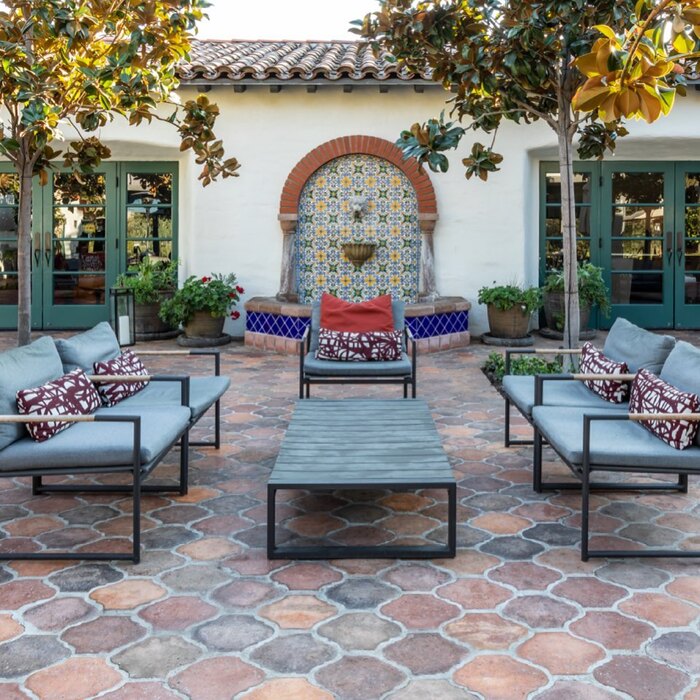
This courtyard makes me want to serve iced tea to strangers. The large irregular pavers read like reclaimed Saltillo, but you can get the same vibe using rustic cement tile in arabesque or scallop shapes. The fountain with the brick arch and hand painted mosaic becomes the hero, while the warm clay floor pulls the seating together.
Why it works. The tile color shifts from pumpkin to smoky gray, which hides dust and gives depth. Outdoor rated encaustic tiles or sturdy concrete tiles hold up well if sealed right. Use a penetrating sealer made for exterior use and add non slip additive if your climate gets wet.
Furniture wise, keep frames black or deep bronze so the cushions float. I’d add striped outdoor pillows and a woven tray. If budget is tight, focus the fancy patterned cement tiles on a medallion in front of the fountain, then use plain cement pavers everywhere else. It tricks the eye and saves money.
Botanical bathroom with blue herringbone floor
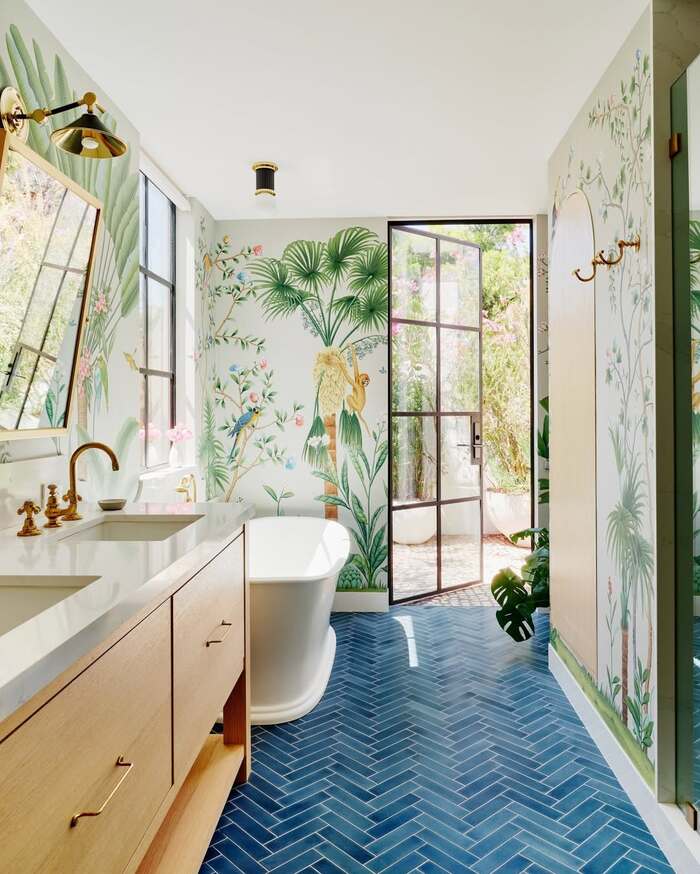
I’m a sucker for color, and this bathroom hits that happy nerve. The floor is a deep ocean blue laid in herringbone. You can do this with elongated rectangle cement tiles for that soft matte glow. The jungle mural on the walls brings in birds and palms, and the brass fixtures set the whole room in warm light.
Here’s what I learned from stalking the comments. Blue hides hair and dust better than white, but shows toothpaste if you’re messy like me. Seal the tiles, then reseal once a year. Use sand colored grout, not bright white, to keep lines calm. Keep the vanity wood tone light so the floor doesn’t feel heavy.
Add one plant in a simple pot and call it a day. If you want to copy the look cheap, do cement bathroom tile on the floor and a peel and stick mural on only one wall. Instant vacation vibes without a passport.
Pattern party sunroom with emerald sofa
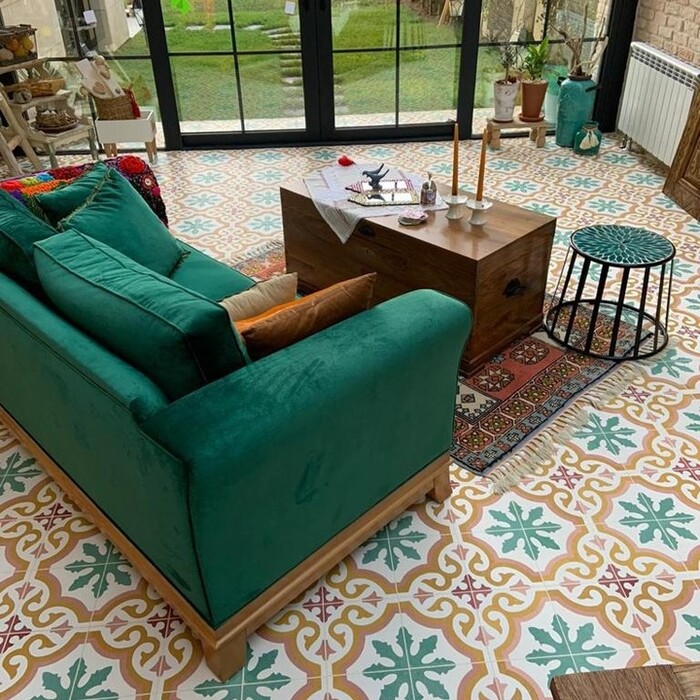
This sunroom screams game night. The floor is a fanned pattern in mint and mustard with soft coral outlines. Classic cement tiles do this best because the pigments feel layered, not flat. The emerald sofa plays off the mint and the wood coffee table grounds it.
My opinion. This looks busy in photos but calm in person because the colors repeat in small ways. That’s the trick. Repeat three shades around the room. Mint in a vase, mustard in a throw, coral in a book spine or candle. Keep the rest neutral. Black framed doors add a crisp line that stops the pattern from running away.
If you do radiant heat, cement floor tiles are happy with it. Just let them acclimate and use flexible thinset. For rugs, choose a flat woven kilim so the pattern on pattern feels intentional. Bonus hack. Hide board games in a trunk that matches the wood tone of your table so the room stays cute after guests leave.
Minimal bath with geometric feature wall
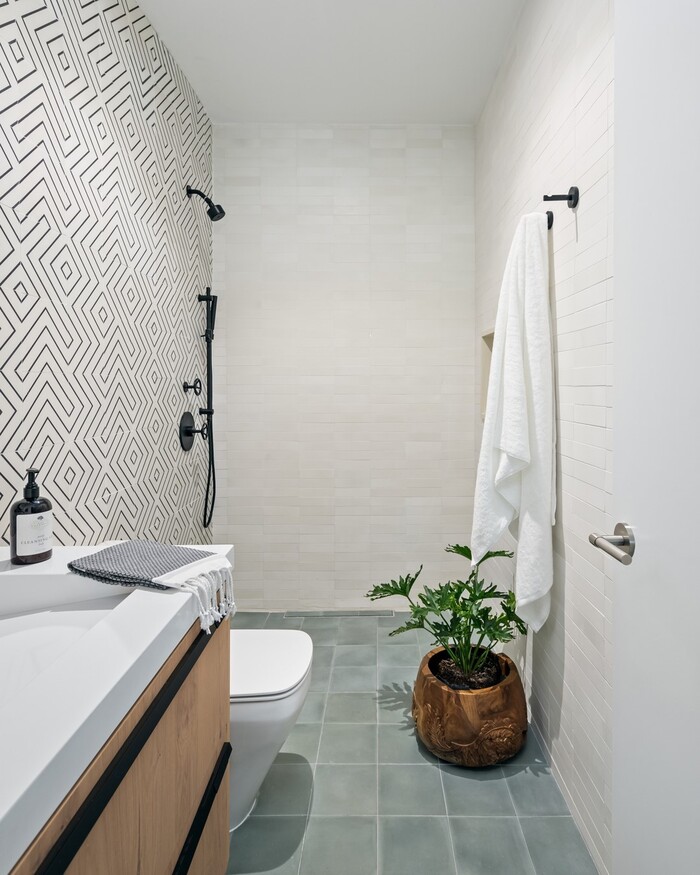
This one is proof that cement doesn’t always mean vintage. The floor is a soft sage green square, very calm. The shower wall goes graphic with a black and white maze pattern. Both can be cement tiles, and the contrast feels new. I’d keep the vanity clean lined in light oak, the fixtures in matte black so they echo the pattern, and add one natural element like a carved wood planter.
Cleaning wise, neutral pH soap and a microfiber mop work best. This is a design where grout decisions matter. Use light gray on the sage floor to maintain that airy hotel vibe. Then go high contrast on the patterned wall so the lines read crisp.
If your bathroom is small, run the same green cement tile up the tub face to make the floor feel longer. One tiny splurge I love. A built in niche lined in the same pattern as the feature wall. It’s like a little surprise when you shower.
Indoor outdoor triangles on the patio
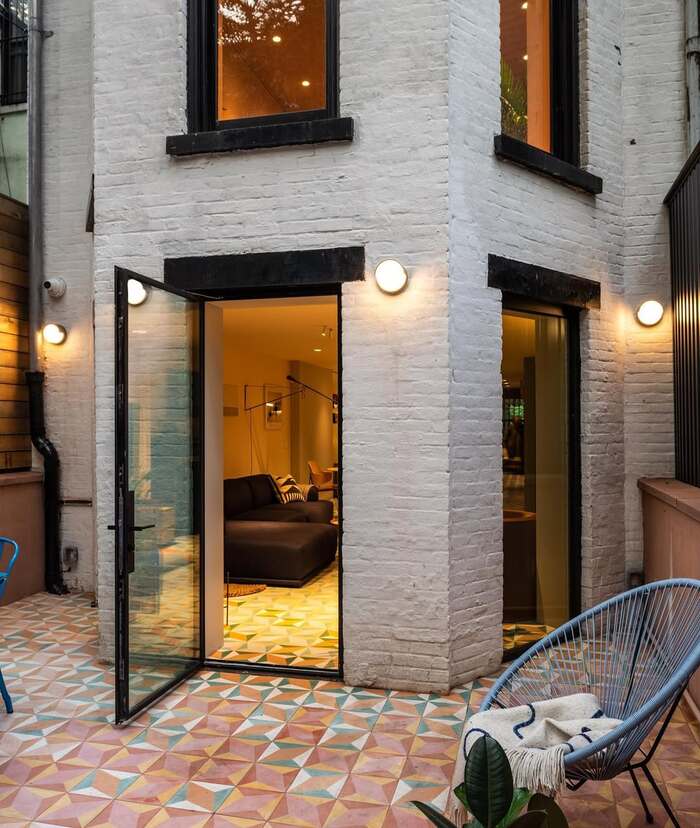
If you like motion, this one dances. The patio uses triangular cement tiles in pink, mustard, and teal. The pattern continues right through the glass doors into the living room, which makes the apartment feel bigger than it is. I love that trick.
Keep the furniture simple so the floor is the star. A single Acapulco chair, a plant with big leaves, and maybe a small side table. That’s it. For longevity, slope the patio just enough for water to run off and seal with a UV resistant top coat. If you’re nervous about pink, choose clay and gray with one accent color. The geometry still pops.
A lot of folks ask if cement tiles stain outside. They can. That’s honest. Wipe spills fast and keep a neutral cleaner by the door. It’s worth it for the vibe of a real indoor outdoor encaustic cement tile moment.
Cubist hallway with 3D illusion
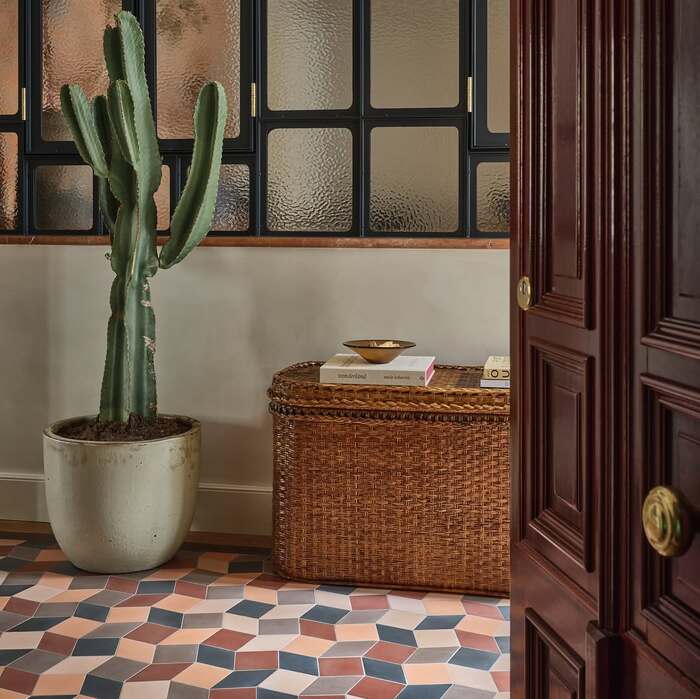
Okay, this foyer is a flex. The cube pattern looks like it pops off the floor. It’s a classic French bistro motif done with three shades of cement tile. With sunlight hitting the matte surface, it feels like art.
What I’d do in real life. Keep walls quiet in limewash or soft plaster so the floor can speak. Add one big plant, maybe a cactus, and simple woven storage. For stairs nearby, run a narrow runner in a solid tone so you don’t get dizzy.
Installation tip I wish I knew earlier. Dry lay a whole row before sticking anything down, because the direction of each cube matters. Get a spacer set that keeps joints consistent. With patterns like this, small shifts show. When guests walk in, they’re going to say wow. And they’ll ask if they can walk on it with shoes. Yes. It’s cement. It likes life.
Black and white kitchen floor with sage cabinets
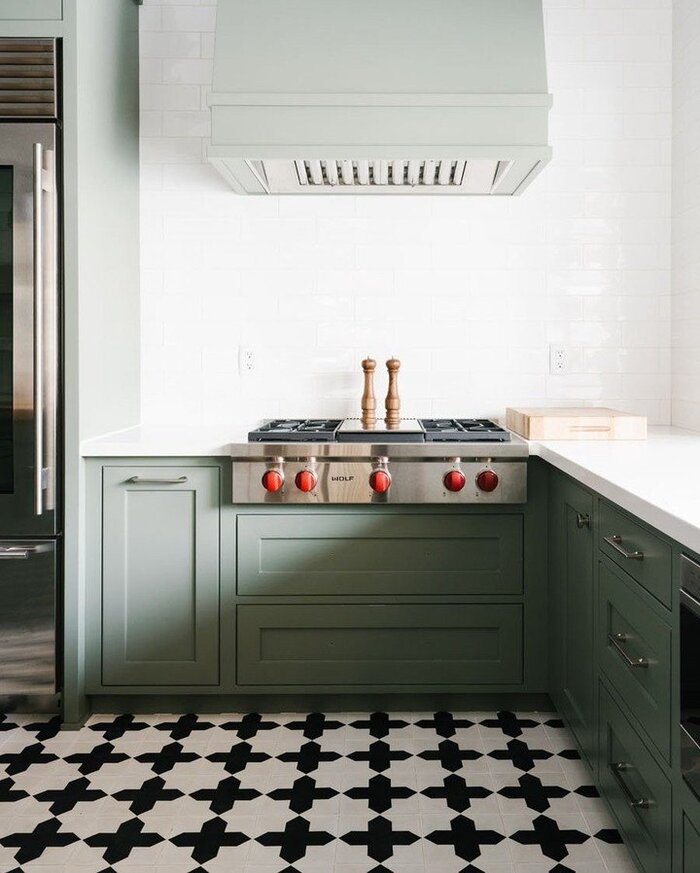
This kitchen checks every box for me. The floor is a black and white star cross pattern done with cement tiles and it plays so nicely with the sage cabinetry. Red stove knobs become spicy punctuation. If you copy, let the backsplash stay simple, either white subway or a soft zellige. You already have the big pattern on the floor.
Keep grout dark on the black sections so crumbs don’t show. I’m messy, I admit it. Use a soft scrub pad for stuck bits and reseal the floor once a year. For rugs, a skinny runner in natural jute sits well on cement and warms toes in the morning.
The cool thing about encaustic floor tiles here is how they hide daily life. Pattern forgives. If your kitchen is small, run the floor pattern under the appliances so the room feels larger. Don’t stop at the toe kicks.
Moody teal backsplash with walnut
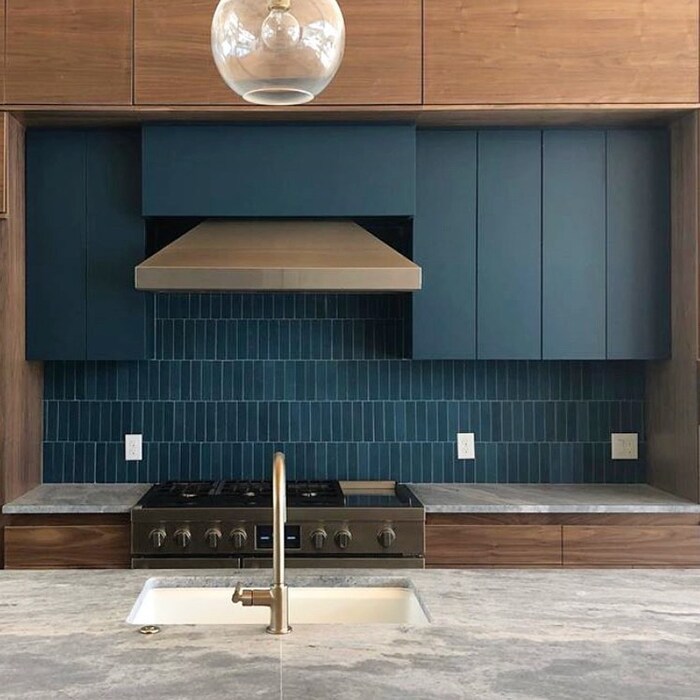
File this under brave but worth it. Deep teal vertical rectangles stack behind the range, and yes, you can get slender cement tiles cut in this shape. The matte finish against walnut cabinets is so rich. I like a quiet gray stone countertop with faint veining, and a simple glass globe pendant so the backsplash stays primary.
Sealing is key near cooktops. Use a food safe sealer and keep a cloth handy for oil splatters. If teal feels strong, choose indigo or forest. Cement wall tile holds color like a denim jacket. It just gets better.
Layout choice matters. Vertical stack reads modern. Offset reads classic. Either is fine. Tie the metal finishes together. Brushed brass faucet and handles keep the warmth going. If budget bites, do the teal cement tiles behind the range only and use plain plaster on the side walls.
Warm patterned kitchen with classic charm
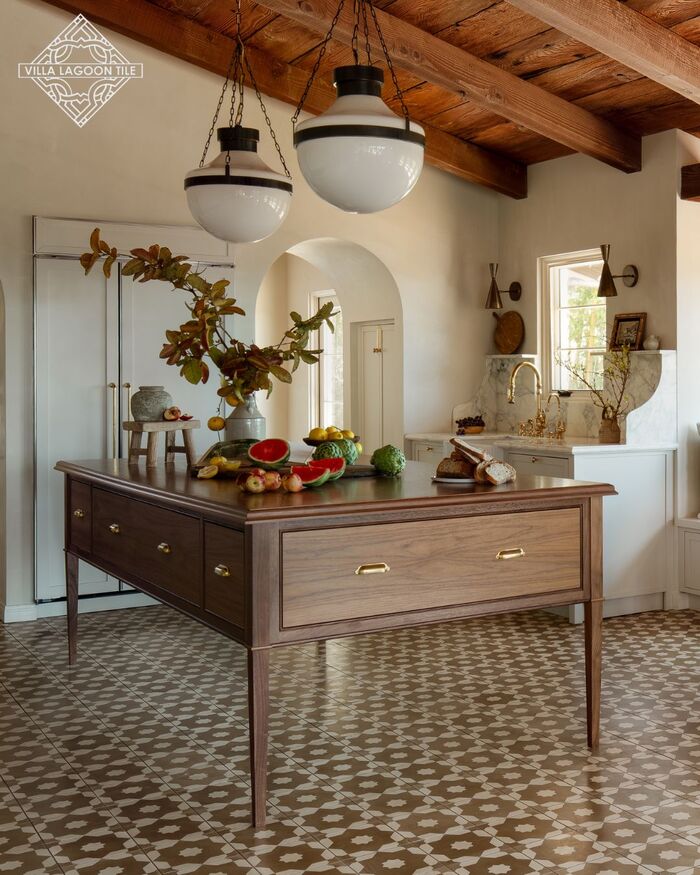
This room gives bakery morning light. The floor uses a soft tan and cream motif that repeats like lace. That’s the magic of cement tile. It makes a new home feel like it has stories. Wood beams overhead, walnut island, creamy walls. I’d repeat the warm tone of the floor in cabinet knobs and a linen curtain under the sink.
Another small trick. Keep baseboards the same color as the walls so your eye rests on the pattern. Cleaning feels easy here because the colorway hides dirt. If you cook a lot, a washable cotton rug in front of the sink saves knees and cleans fast.
People ask if cement tiles chip. They can if you drop a cast iron pan point down. But unlike printed porcelain, the color goes deeper, so small chips almost vanish. That’s why old cafés with encaustic tiles still look charming, not worn out.
Grand hotel corridor in caramel and cream
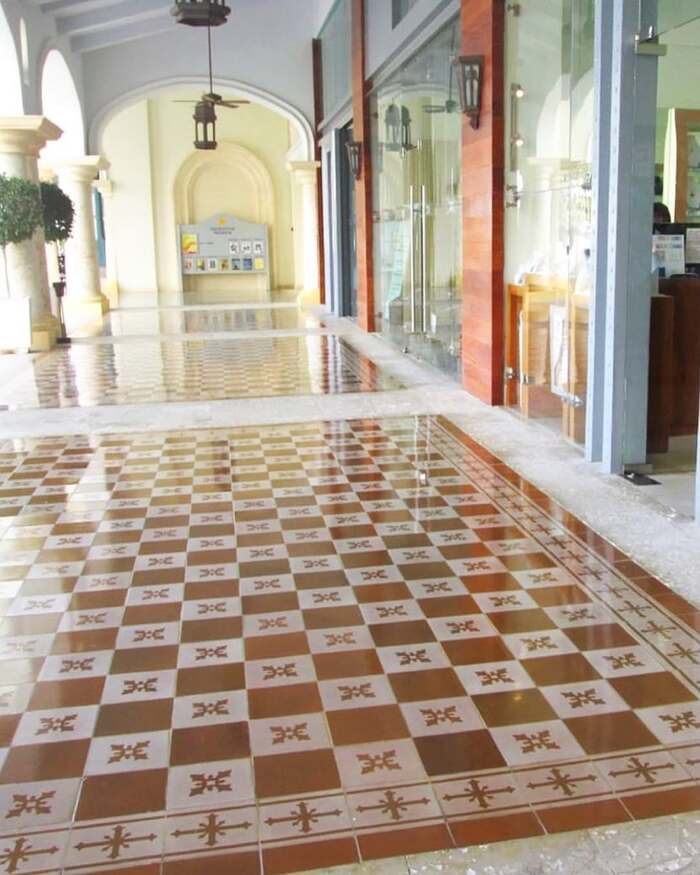
This checkerboard walkway feels like a seaside resort. Glossy caramel and cream squares line up with small emblem details at the corners. You can get the same tailored vibe with polished cement tiles if you want that subtle sheen. I’d run it down a long hall and repeat the warm caramel in door hardware and picture frames.
Lighting matters. Simple globe sconces keep the mood bright. Grout choice. Go tone on tone so the emblems stay crisp. If you’re tempted by black and white, try brown and white first. It’s kinder, less cold.
Maintenance is not scary here. A neutral cleaner and a microfiber mop, then buff with a dry towel for a soft glow. If you want drama, add a thin contrasting border in darker brown. It frames the hall like a rug and costs less than a full runner.
Quick guidance to nail the look
A few things I wish someone told me on day one. Seal twice. Once before grout to prevent haze settling into the pores, and once after grout for protection. Keep extra tiles. Cement tiles are handmade, so future batches can shift a hair. Order 10 percent more.
Plan thresholds. Where patterned floors meet wood, use a slim brass strip so the transition feels neat. Test cleaning products in a corner. Acid cleaners will etch, which is a fancy word for sad.
Most of all, be brave with color. A muted clay, a deep teal, a faded mint. These shades make rooms feel lived in and kind.
FAQ
What is the difference between cement tile and ceramic tile?
Cement tile is made from pigmented cement pressed in a mold, not fired. Ceramic is clay fired in a kiln. Cement has a matte, stone like feel and deep color. Ceramic is usually glazed and harder to stain.
Can I use cement tiles in a shower or wet area?
Yes, many people do. Seal everything well, slope the pan correctly, and keep a squeegee handy. Use a neutral cleaner and avoid harsh acids.
Do cement tiles need sealing?
Absolutely. Seal before and after grouting. For kitchens and baths, reseal once a year. For patios, choose a UV resistant exterior sealer.
Are cement tiles slippery?
Most have good grip because of the matte surface. For outdoor areas, you can add a non slip additive to the sealer if you want extra traction.
Can I put cement tile over radiant heat?
Yes. Let the tiles acclimate, use a flexible thinset, and ramp the heat slowly after install to avoid shock.
How do I clean cement tiles day to day?
Neutral pH cleaner, warm water, and a microfiber mop. Wipe spills fast, especially wine, lemon, or oil. No vinegar, no bleach.
Will patterned cement tiles make my small room feel busy?
Keep the palette tight and repeat the main colors three times in the room. Use simple walls and let the floor be the star. It usually feels bigger, not smaller.
Can I DIY install cement tiles?
You can if you’re patient. Dry lay the pattern, use spacers, and read the instructions twice. If the pattern is complex, hire a pro for peace of mind.
What grout color should I choose with cement tiles?
Match the lightest or mid tone in the tile. Avoid bright white unless the design calls for it. Tone on tone hides dirt and keeps patterns clear.
Do cement tiles fade outside?
With a good sealer and some shade, they hold up well. Direct harsh sun may soften color over many years. Honestly, a tiny bit of patina looks great.
Conclusion
I started this journey because Instagram would not stop throwing beautiful floors at me. Now I’m the person who talks grout at dinner, and I don’t even feel bad. A cement tile floor or wall brings warmth, history, and pattern that paint just can’t do.
Whether it’s a Spanish style patio, a teal kitchen backsplash, or a cheerful sunroom, these tiles add soul. Choose colors with care, plan your layout, and seal like you mean it. Then live in the space. Spill a little coffee, wipe it, keep going. Homes are for living, and cement tiles handle life with style.
If you end up trying one of these ideas, tag me. I’ll be the weirdo cheering and also asking what grout you picked.
